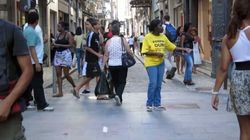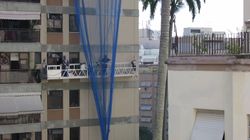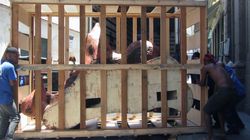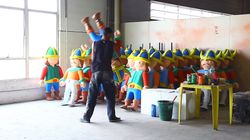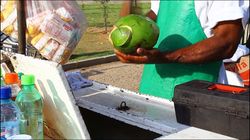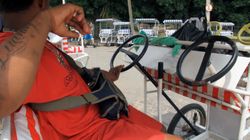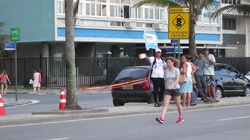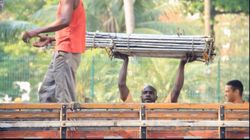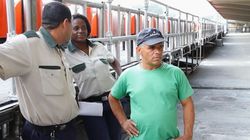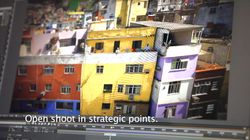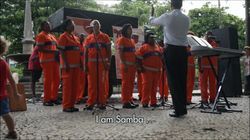Rio de Janeiro|Brazil
Statistical Data
Google entries for Rio de Janeiro 382.000.000
Google entries per inhabitant 60,43
City Founding 1565
Surface area
City area 1.182 km²
Metropolitan area 6.567 km²
http://de.wikipedia.org/wiki/Rio_de_Janeiro
CLIMATE DATA
Max. temperature Ø 27.2
Min. temperature Ø 21
Rainfall / year (mm) 1.172,9
Days of rain 109
http://de.wikipedia.org/wiki/Rio_de_Janeiro
POPULATION
Inhabitants / city 6.320.446 (2010) [1]
Inhabitants / metropolitan area 12.043.000 (2012) [2]
Population density / city 5.347,2 inh. / km² (2010) [1]
Population density / metropolitan area 1.833,6 inh. / km² (2012)
[1] http://de.wikipedia.org/wiki/Rio_de_Janeiro
[2] http://www.demographia.com/db-worldua.pdf
Age groups in %, 2009
0-14 18.2
15-24 14.6
25-59 49.9
>60 17.3
http://rio-negocios.com/en/uploads/2011/04/Relatorio-Data-Rio-Ingles.pdf
Population history (metropolitan area)
1950 2.864000
1970 7.040000
1990 9.682000
2010 11.496000
http://books.mongabay.com/population_estimates/full/Rio_de_Janeiro-Brazil.html
Population composition in Rio (metropolitan area)
White 53%
Black 12%
Mixed 33%
Asian 0.5%
http://en.wikipedia.org/wiki/Demographics_of_Rio
RELIGION (2010)
Catholic 51,09%
Protestant 23,37%
Irreligious 13,59%
Spiritist 5,90%
Umbanda and Candomblé 1,29%
Jewish 0,34%
http://en.wikipedia.org/wiki/Rio_de_Janeiro#Religion
TRAFFIC
Cars 2001 1,74 million
2011 2,82 million
Motorbikes 2001 127.435 2011 430.733
http://www.riogringa.com/my_weblog/2012/10/the-paulistanization-of-rio.html
Public Traffic
Metro lines 2
Metro network 46 km
Metro passengers per day (in 1.000) 645
http://www.gtai.de/GTAI/Navigation/DE/Trade/maerkte,did=636800.html&channel=premium_channel_gtai_1
A third line is under construction and to be opened for the Olympic Games in 2016. The line is supposed to combine the International Airport with the Olympic grounds in the West of the city.
Suburban railway
Network 270 km
Passengers per day (in 1.000) 540
http://www.gtai.de/GTAI/Navigation/DE/Trade/maerkte,did=636800.html&channel=premium_channel_gtai_1
Bus
Number of buses 8.700 [1]
Bus lines 440 [2]
Passengers 4 million [2]
Bus Companies ca. 100 [3]
[1] http://riotimesonline.com/brazil-news/rio-politics/rio-to-reduce-a-third-of-buses-by-2016
[2] http://www.oxbridgewriters.com/essays/politics/growth-of-rio-de-janeiro.php
[3] http://riotimesonline.com/brazil-news/opinion-editorial/opinion/the-curmudgeon-on-vans
BRT (Bus Rapid Transport) corridor
For 2016 Rio schedules to establish 4 BRT corridors, three of them for express buses only. The corridors will be ca. 150 km long. The express buses are supposed to transfer 1,5 million passengers per day.
http://insights.wri.org/news/2012/06/rio-de-janeiro-opens-first-bus-rapid-transit-corridor
Informal transport (para transit) by vans (minivans with max. 8 passengers)
Registered vans 5.800 [1]
Number of vans (est. 2007) 10.000 [2]
Passengers / day (est. 2007) 600.000 [2]
[1] http://riotimesonline.com/brazil-news/rio-politics/rios-van-transport-system-under-review/
[2] http://www.bauwelt.de/sixcms/media.php/829/10793531_ba67a8bec6.pdf
There are several other, lower-volume transport carriers such as ferries, a historical tram in Santa Teresa (at the moment out of service), mountain railways and cable cars at the sugar mountain and Corcovado, and a highly modern gondola lift in the Favela „Complexo do Alemão“.
Employees by profession groups in Rio de Janerio (in %; 2012)
Mining, oil production, manufacturing sector 12.2
Supply of electricity, gas, water, building industry 7.5
Commerce, car repair 17.6
Household supply, fuel sales, finance,
real estate and company services 15.8
Public administration, defense, education 19.2
Health and social services 7.1
other services 20.2
other activities 0.4
http://www.ibge.gov.br/english/estatistica/indicadores/trabalhoerendimento/pme_nova/pme_201209rj_01.shtm
ECONOMIC OUTPUT
GDP (2008) 201 billion USD
GDP (2025) 407 billion USD
GDP per Capita (2008) 16.9 000 USD
http://www.ukmediacentre.pwc.com/imagelibrary/downloadMedia.ashx?MediaDetailsID=1562
Poverty line in Brazil
16.2 million people (8.5% of the population) are living below the poverty line of 26,85 Euro per month.
http://riotimesonline.com/brazil-news/rio-business/brazil-strives-for-economic-equality
Average income (Rio de Janeiro, 2012)
Private sector 602,28 EUR
Public sector 1.223,83 EUR
http://www.ibge.gov.br/english/estatistica/indicadores/trabalhoerendimento/pme_nova/pme_201209rj_03.shtm
Official minimum wage (2012) 235 EUR
http://riotimesonline.com/brazil-news/rio-politics/brazil-standard-of-living-20-year-outlook/
Workers who earn minimum wage 896.000 (sept. 2012) =
% of all employees 16,3
http://www.ibge.gov.br/english/estatistica/indicadores/trabalhoerendimento/pme_nova/pme_201209rj_01.shtm
UNIONS
2004 7,4 million workers are organized in unions
CUT is the Central Única dos Trabalhadores, Brazil's biggest union umbrella association founded in 1983.
Quelle: http://de.wikipedia.org/wiki/Central_%C3%9Anica_dos_Trabalhadores
STRIKES
February 9, 2012 Strike of the police, fire fighters and prison officers
"The main thing wrong with police forces in Rio, Bahia, and in the rest of the country is the poor wages paid," said Mingardi. "This is the driving force of the strikes and of the problems affecting the forces." Carnival starts officially next Friday, but massive street parties that can draw up to 2 million people to the streets have already kicked off the merry maelstrom that consumes this city every summer. Rio's Carnival pumps more than $500 million into the city's economy annually. The first day of the strike went calmly. Union leaders said 30 percent of units would remain active to take care of emergencies; adherence rates hovered between 50 and 70 percent for the roughly 60,000 police, firefighters and prison guards on strike.
http://www.huffingtonpost.com/2012/02/10/rio-de-janeiro-police-strike_n_1269570.html
Displaced persons / Forced evictions during construction for the Olympics / World Cup
Although the government does not wish to disclose any information on the violent evictions taking place over the course of construction, the number of people affected is estimated at approximately 170,000.
Articulación Nacional de los Comités Populares de la Copa, “Megaeventos y violaciones a los derechos humanos en Brasil”, diciembre de 2011,
http://www.quetzal-leipzig.de/lateinamerika/brasilien/der-bittere-beigeschmack-der-meisterschaften-brasilien-vor-der-fusballweltmeisterschaft-und-den-olympischen-spielen-19093.html
LIVING COSTS
Working hours required for the purchase of…
1 Big Mac min. 45
1kg bread min. 33
1kg rice min. 12
1 iPhone 4S 16GB hrs. 160
http://www.ubs.com/global/en/wealth_management/wealth_management_research/prices_earnings.html
Prices (in EUR)
12 eggs 1,28,-
1 kg tomatoes 1,46,-
Bread for 2 people (1 day) 1,00,-
0,5 l beer in a super market 1,13,-
1 l milk 0,99, -
Cleaning woman (1 hour) 5,68,-
Monthly rent for a 85 qm-flat
in an expensive neighbourhood 1.379,-
1 l petrol 1,12,-
Monthly ticket for public transport 60,-
Cab drive (8 Km) 8,56,-
http://www.expatistan.com
Since 2008, average rents on housing have doubled citywide.
http://rioonwatch.org/?p=3148
MEGA-EVENTS IN RIO
2012 Rio 20+ (United Nations Conference on Sustainable Development)
2013 World Youth Day
2014 FIFA World cup
2015 450-years anniversary of Rio
2016 Olympic Games
FIFA World cup 2014 + Olympic Games 2016
Investments in Brazil 25,9 billion Euro [1]
Thereof private investments 1% [2]
New jobs 700.000 [1]
Resettlements in connection with the
World cup and the Olympics 2016 150.000-170.000 people [2]
Expected foreign visitors 600.000 [3]
[1] http://www.tradingfloor.com/posts/the-economic-impact-of-brazils-2014-world-cup-and-2016-olympics-526315521
[2] http://www.solidar.ch/data/0DF06392/Dossier_layout_en.pdf
[3] http://www.bbc.co.uk/news/business-15824562
FAVELAS (SLUMS) IN RIO
Number of favelas in Rio ca. 1000
Number of inhabitants in the Favelas in Rio 22,03% [1]
Growth of the favela population in the last decade 27,7% [2]
Growth of the population in Rios in the last decade 3,4% [2]
[1] http://riotimesonline.com/brazil-news/rio-daily/rios-favela-population-largest-in-brazil
[2] http://riotimesonline.com/brazil-news/rio-politics/brazil-standard-of-living-20-year-outlook
Largest favela Rocinha
Size 0,84 km2
Population 69,356 (2010, population census)
Population according to
unofficial estimates 100.000 - 300.000
http://riotimesonline.com/brazil-news/rio-daily/rios-favela-population-largest-in-brazil
Favela characteristics
95 % of the buildings are of bricks and concrete [1]
89% have more than 3 bedrooms [1]
90% of the residents have work [1]
26% of the residents are independent [1]
76% live for more than 10 years in the Favela [1]
44% of the households have a computer [1]
13% of the residents belong to the “A/B”-class (= more than 1.600, - EUR / month) [2]
[1] http://rioonwatch.org/?p=3367
[2] http://riotimesonline.com/brazil-news/rio-real-estate/wealth-growing-in-some-favela-communities
UPPS
For decades, favelas have been legal vacuums without state supervision, controlled by drug gangs. With the establishment of the so-called UPPS (Unidade de Polícia Pacificadora) since 2008, the territories in the hand of the gangs are being reconquered. the goal is to establish 40 UPPS before the world cup in 2014. Right now 3000 policemen are taking part in the programme: in 2014 it will be 12.000.
Cocaine
After the USA, Brazil is the worldwide biggest consumer worldwide of cocaine (20% of world consumption) and the biggest consumer of crack.
http://www.examiner.com/article/police-and-commandos-crack-down-on-cocaine-brazil
Fatalities with police involvement (2008)
Rio State 1.137
USA 371
http://www.blackagendareport.com/content/police-death-squads-haunt-brazil%E2%80%99s-favelas
Relation between arrests and fatalities with police involvement (2008)
Arrests per dead person (Rio) 23
Arrests per dead person (US) 37.000
http://www.ft.com/cms/s/0/ca897b8e-2bc0-11e1-98bc-00144feabdc0.html#axzz2CKK064OR
Reductions in crime levels in a favela with a UPP
Delicts with lethal consequences minus 78% [1]
Lethal consequences with police
involvement minus 98% [1]
Homicide rate minus 10-25% [2]
Robbery rate minus 10-20% [2]
Assaults from 29.4 to 99 / pro 100,000 residents [1]
Rapes from 1.3 to 4.8 / pro 100,000 residents [1]
Incidents of domestic violence from 27 to 84.6 / pro 100,000 residents [1]
[1] http://riotimesonline.com/brazil-news/rio-politics/upps-reduce-violent-deaths-by-78-percent/
[2] http://www.newyorkfed.org/research/staff_reports/sr542.pdf
Prior to the UPP operations, the favelas functioned as a parallel society where the “lei do morro” (law of the favela) was sovereign and brutally enforced by the druglord in charge. In the absence of that enforcement, it could either be that crimes have increased or that crime reporting has increased, since the crimes which were previously only reported to the druglord are now being reported to the police.
http://riotimesonline.com/brazil-news/rio-politics/upps-reduce-violent-deaths-by-78-percent
Economic growth in a pacified favela +23%
http://riotimesonline.com/brazil-news/rio-politics/upp-favelas-see-23-percent-business-growth
Development of real estate prices in a pacified favela
“A home near me cost about R Dollar 20,000 three years ago and now you couldn’t get it for less than R Dollar 50,000 [Dollar30.600],” said Juan Sousa Silva, the director of Grupo Eco, a youth group in Santa Marta.
http://www.ftd.de/karriere/business-english/:business-english-housing-boom-raises-fears-of-brazil-bubble/60067119.html
Development of real estate prices close to a UPP +15%
http://www.newyorkfed.org/research/staff_reports/sr542.pdf
REAL ESTATE PRICES IN RIO
Super-economic segment 1.220 EUR / m2
Economic segment 1.235 EUR / m2
Middle segment 1.947 EUR / m2
Mid-high segment 2.110 EUR / m2
High-end segment 3.314 EUR / m2
From January 2008 to July 2012, average house prices in Rio de Janeiro rose by 178.2% (118.4% in real terms).
http://www.nuwireinvestor.com/articles/brazilian-property-prices-increasing-59841.aspx
According to the website for the Superior Electoral Court (TSE), of the ten largest corporate donations received by the campaign that elected Eduardo Paes in 2008, all ten were from the construction or real estate industries. In total, R$11.4 million were collected. Moreover, according to the National Newspaper Association (ANJ), the “real estate” sector is the largest advertiser within the newspaper sector, with over 4 million dollars in 2010, followed by “vehicles, parts and accessories.” These data shed light on the discourses and actions that are impacting the city.
http://rioonwatch.org/?p=2032

